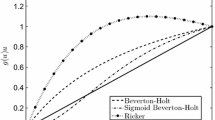Abstract
In many models of genotypic evolution, the vector of genotype populations satisfies a system of linear ordinary differential equations. This system of equations models a competition between differential replication rates (fitness) and mutation. Mutation operates as a generalized diffusion process on genotype space. In the large time asymptotics, the replication term tends to produce a single dominant quasi-species, unless the mutation rate is too high, in which case the asymptotic population becomes de-localized. We introduce a more macroscopic picture of genotypic evolution wherein a random fitness term in the linear model produces features analogous to Anderson localization. When coupled with density dependent non-linearities, which limit the population of any given genotype, we obtain a model whose large time asymptotics display stable genotypic diversity.
Similar content being viewed by others
References
R. Abou-Chacra, P. W. Anderson and D. J. Thouless, A self consistent theory of localization. J. Phys.C: Solid St. Phys. 6:1734–1752, (1973).
P. W. Anderson, Absence of diffusion in certain random lattices. Phys. Rev. 109:1492–1505, (1958).
P. W. Anderson, Suggested model for prebiotic evolution: The use of chaos. Proc. Natl. Acad. Sci. 80:3386–3390, (1983).
E. Baake, M. Baake and H. Wagner, Ising quantum chain is equivalent to a model of biological evolution. Phys. Rev. Lett. 78:559–562, (1997).
R. Carmona and J. Lascoux, Spectral Theory of Random Schrödinger Operators, (Birkhäuser, Boston-Basel-Berlin, 1990).
S. S. Chow, C. O. Wilke, C. Ofria, R. E. Lenski and C. Adami, Adaptive radiation from resource competition in digital organisms. Science 305:84–86, (2004).
J. F. Crow and M. Kimura, An Introduction to Population Genetics Theory, (Harper and Row, New York, 1970).
M. Eigen, Molekulare Selbstorganisation und Evolution (Self organization of matter and the evolution of biological macro molecules.). Naturwissenshaften 58:465–523, (1971).
M. Eigen, J. McCaskill and P. Schuster, Molecular quasi-species. J. Phys. Chem. 92:6881–6891, (1988).
M. Eigen, J. McCaskill and P. Schuster, The molecular quasi-species. Adv. Chem. Phys. 75:149–263, (1989).
M. Eigen and P. Schuster, A principle of natural self-organization. Part A. emergence of the hyper cycle. Naturwissenschaften 64:541–565, (1977).
J. Hermisson, H. Wagner and M. Baake, Four-state quantum chain as a model for sequence evolution. J. Stat. Phys. 102:315–343, (2001).
K. Jain and J. Krug, Adaptation in simple and complex fitness landscapes. arXiv:q-bio, PE/0508008 v1:1–42, (2005).
J. McCaskill, A localization threshold for macromolecular quasi-species from continuously distributed replication rates. J. Chem. Phys. 80:5194–5202, (1984).
D. R. Nelson and N. M. Shnerb, Non-Hermitian localization and population biology. Phys. Rev. E 58:1383, (1998).
J.-M. Park and M. W. Deem, Schwinger Boson formulation and solution of the Crow-Kimura and Eigen models of quasispecies theory, submitted. J. Stat. Phys. 1–33, (2006).
L. A. Pastur and A. Figot, Spectra of Random and Almost Periodic Operators, (Springer Verlag, Berlin-Heidelberg-New York, 1992).
P. B. Rainey and M. Travisano, Adaptive radiation in a heterogeneous environment. Nature 394:69–72, (1998).
M. Reed and B. Simon, Methods of Modern Mathematical Physics VI: Analysis of Operators, (Academic Press, New York-San Francisco-London, 1978).
D. B. Saakian, E. Muñoz, C.-K. Hu, and M. W. Deem, Quasispecies theory for multiple-peak fitness landscapes. Phys. Rev. E 73:041913-1–10, (2006).
M. E. Taylor, Partial Differential Equations, Vol. 3, vol. 117 of Applied Mathematical Sciences, (Springer, New York, 1996).
D. J. Thouless, Anderson’s theory of localized states. J. Phys.C: Solid St. Phys. 3:1559–1566, (1970).
H. Wagner, E. Baake and T. Gerisch Ising quantum chain and sequence evolution. J. Stat. Phys. 92:1017–1052, (1998).
Author information
Authors and Affiliations
Additional information
Research partially supported by DARPA under the FUNBIO program and the Francis J. Carey Term Chair.
Rights and permissions
About this article
Cite this article
Epstein, C.L. Anderson Localization, Non-linearity and Stable Genetic Diversity. J Stat Phys 124, 25–46 (2006). https://doi.org/10.1007/s10955-006-9149-0
Received:
Accepted:
Published:
Issue Date:
DOI: https://doi.org/10.1007/s10955-006-9149-0




